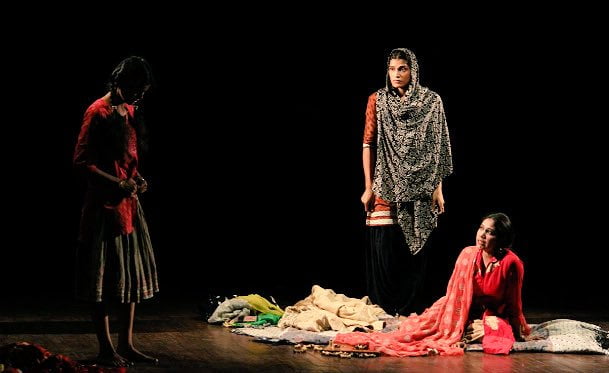The first time I read Lihaaf, I was expecting to be struck by the progressiveness of its mere existence in terms of talking about homosexuality and female desire in the 1940s. But what followed was confusion and questions.
Ismat Chughtai’s Lihaaf challenged the conventional feminine qualities of obedience, abstinence and modesty in a patriarchal society and empathized womanhood with emotions and desires. Yet, I feel that we as readers forgot to understand an essential element in this story.
It was one of the few stories that revolve around complex female characters with desires and sexual needs, who hold agency over their actions and unabashedly practice their sexuality. One of the primary characters being Begum Jan, a woman deprived of her husband’s affection and attention.
Her husband Nawab Sahib directed all his attention at funding the education of “young, fair and slim-waisted boys”, implying paedophilia under the garb of benevolence and isolating Begum and her needs. Being subjected to this loneliness, she finds solace in the company of her masseuse, Rabbu. The nature of their relationship turns sexual and “suddenly her emaciated body began to fill out. Her cheeks became rosy; beauty, as it were, glowed from every pore!”
The controversy surrounding Lihaaf emerged due to the representation of unadulterated female desire, sexuality, and queerness. The story was denounced and celebrated for the same reason of setting a discourse around homosexuality and providing an alternate perspective that deviated from patriarchal expectations.
the child seemed incapable to comprehend the manipulation of her body for someone else’s desire.
As the story progressed, I grew increasingly uncomfortable by the narrative of a nine-year-old girl who witnesses the sexual encounters and is then used (or rather abused) by Begum Jaan to satiate her desire in the absence of Rabbu. I instinctively thought of the traumatic experiences of a child who seemed incapable to comprehend the manipulation of her body for someone else’s desire.
Here are some excerpts of her encounter with Begum Jaan that seem like an ambiguous representation of child sexual abuse by recollecting it trivially:
“Here”, she would take my hand and place it where it itched and I, lost in the thought of the babua, kept on scratching her listlessly while she talked. “Listen… you need some more frocks…”
“Come here and lie down beside me…” She made me lie down with my head on her arm. “How skinny you are… your ribs are coming out.”
She began counting my ribs. I tried to protest. “Come on, I’m not going to eat you up. How tight this sweater is! And you don’t have a warm vest on.” I felt very uncomfortable. “How many ribs does one have?” She changed the topic.
I wanted to run away, but she held me tightly. I tried to wriggle out and Begum Jaan began to laugh loudly. To this day, whenever I am reminded of her face at that moment. I feel jittery.
A strange fright overwhelmed me. Begum Jan’s deep-set eyes focused on me and I felt like crying. She was pressing me as though I were a clay doll and the odour of her warm body made me almost throw up. But was like one possessed.
I could neither scream nor cry. After some time she stopped and lay back exhausted. She was breathing heavily and her face looked pale and dull. I thought she was going to die and rushed out of the room…
To have a coherent understanding of this story, we must take in the child’s narrative and explore an alternative interpretation.
The clear breach of the personal boundary, the promise of gifts, the confusion and shame experienced by the child, all of these meet the signs of child sexual abuse. The child’s withdrawal from her presence, self-doubt and reprimanding herself for wanting to tell her mother about her experiences all signify the doubts that a child faces after the unbelievable abuse by a trusted individual, “What could I have said to anyone? That I was afraid of Begum Jan? Begum Jan, who loved me so dearly?”
To have a coherent understanding of this story, we must take in the child’s narrative and explore an alternative interpretation. This would not only increase our understanding of the story better but also warn readers from trivializing the details of child sexual abuse.
The purpose of this piece is not to question the progressive nature of Lihaaf, but to provide an alternate perspective on the story by shifting attention from the salient theme of homosexuality. If there is anything we’ve learnt from the feminist interpretation of history, it is to constantly question popular narrative and understand it from another subject’s perspective and to overcome the ambiguity surrounding their experiences.
Also Read: The Taboo Of Child Sexual Abuse In India
Featured Image Credit: Twitter
About the author(s)
is trying her best.





Thank you for your analysis; as a queer desi woman, I was surprised hearing the initial buzz around the story, and got really uncomfortable and disappointed completing it.
Hi! I just read Lihaaf for the first time (i’m Indonesian) and i feel how horrifying for the child to have such experience. And some questions arise in my mind, is this how it goes? A victim become a perpetrator? Begum Jaan might be the victim of her husband’s physical and emotional neglect (plus victim of patriachal system), but do all of those merely justify her action to abuse her own niece? Is this a story about how far lust can drag one’s action? Are we all Begum Jaan?
doing a paper on the topic